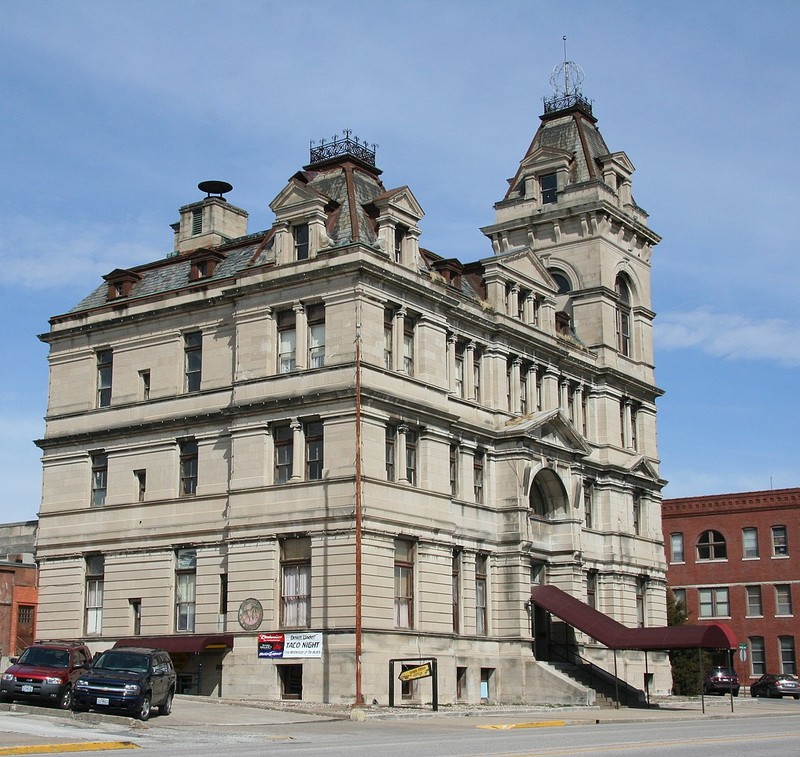Former Post Office, Court House and Federal Building in Hannibal
Introduction
Text-to-speech Audio
The United States Congress authorized the establishment of the Court House and Post Office in Hannibal, Missouri, on May 25, 1882. Imposing federal buildings often symbolized their importance and served as symbols of a town's significance. Public officials acquired the property on July 31, 1883; construction on the historic federal building finished in the summer of 1884 (in 1934, a one-story addition was added.) The building stands as the second oldest U.S. civil structure in Missouri. Its most notable feature involves the Second Empire architectural style, named for the French architectural designs routinely employed during the rule of Napoleon III (the "second empire).
Images
Former Federal Building, Post Office, and Court House in Hannibal

Backstory and Context
Text-to-speech Audio
The historic building's Second Empire style derives inspiration from sixteenth and seventeenth-century French designs. Alfred B. Hullett adapted the French techniques to U.S. government building designs when he served as Supervising Architect of the U.S. Treasury from 1865 to 1874. The size and elaborate design speak to the importance of the building, both because it's a federal building and to demonstrate the significance of Hannibal as the building's home. U.S. Representative for Hannibal, William Henry Hatch, famous for authoring the Hatch Act of 1887 (dealing with agricultural research; see links below for more info), sponsored the creation and construction of the Hannibal federal building. Moreover, when funds ran low during construction, Hatch shepherded four additional appropriations through Congress to ensure its completion as initially designed.
The Post Office occupied the first floor and basement while the Internal Revenue Service, U.S. Weather Bureau (1892 - 1933), Pension Bureau (1895 - 1899), Army & Navy recruiters (1930 - 1960), and the Prohibition enforcement officer (roughly 1920 - 1933) occupied various spaces within the building. And despite Congress waiting until 1887 to authorize the U.S. Court for the Eastern District of Missouri and their infrequent usage of the building (they only met in Hannibal twice a year, for less than two weeks at a time), the court occupied most of the second and third floors. The U.S. Circuit Court for the district met in the building until its abolishment in 1912.
Increased postal volume led to calls for the expansion of the building starting in 1922, but it took until 1932 for funding to materialize and another two years for the wing to open in 1934. The government erected a new federal building in 1960 across the street, allowing the former (now-historic) structure to serve as the Naval Reserve Building, which remained its function until 1979.
The city received the Old Federal Building from the federal government in 1982, and they leased it to Franklin Winters shortly thereafter. Winters leased the Old Federal Building at 600 Broadway until 2003. He operated restaurants and bars in the building, but city officials discovered bird droppings and dead birds on the building's upper floors; the building sat in a severe state of disrepair. Since then, the building has been repaired, and a bar occupies its lowest floor, but questions remain regarding its long-term purpose.
Sources
"Second Empire." Architectural Styles of America and Europe. Accessed November 9, 2022. https://architecturestyles.org/second-empire/.
Esley Hamilton, Esley. "Nomination Form: U.S. Post Office and Court House." National Register of Historic Places. mostateparks.com. 1980. https://mostateparks.com/sites/mostateparks/files/Federal%20Bldg.pdf.
Naffziger, Chris. "Former Federal Building, Hannibal." Saint Louis Patina. September 5, 2020. https://stlouispatina.com/former-federal-building-hannibal/.
"Status of Hannibal's old Federal Building in dispute." Herald-Whig. June 27, 2003. https://www.whig.com/archive/article/status-of-hannibals-old-federal-building-in-dispute/article_1e9f68fd-de81-58d6-832f-f4d53cdf6bb4.html.
By Jonathunder - Own work, GFDL 1.2, https://commons.wikimedia.org/w/index.php?curid=14784778
